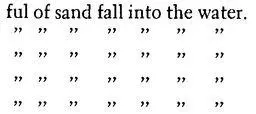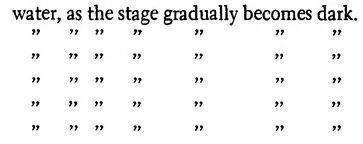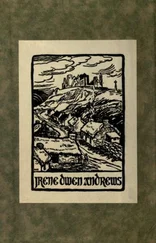Once the ward is outside, the stage slowly becomes dark.
By now we have become accustomed to the music.
The pause is longer this time, for the ‘scenery is being turned inside out.
A revolving stage needs only to revolve.
Otherwise, the scenery is turned around in the dark.
It becomes bright: it is a rainy day.
Warden and ward set up the objects on the stage: the large, longish object, covered by the black raincoat, which they have to bring onstage together, the stool, beets, melons, pumpkins.
When everything has been distributed on the stage, the ward sits down on the stool while the warden stands next to the mysterious object.
Without an actual beginning the play has begun again: the warden takes the rubber coat off the object, so that we see that it is a beet-cutting machine.
The warden puts on the raincoat (he is still barefoot) and, to test the machine, lets the cutting knife drop down several times without, however, cutting any beets.
The ward gets up and walks to the machine. The warden bends down for a beet, shoves it into the machine, and pulls down the cutting knife with one brief, effortless movement, as he indicates with a movement: the beet falls down, its top shorn off.
The warden repeats the process in detail, demonstrating: another beet falls down.
The ward watches, not completely motionless, but without moving very much.
The warden repeats the process.
The ward fetches a beet but makes many superfluous movements and detours; we can hear his hobnail boots on the floor as well as the bare feet of the warden, who now goes to the side and straightens up.
The ward raises the cutting knife, shoves the beet up to its top into the machine, and hacks off the top.
The warden steps up to him, stands beside him, steps back again …
The ward goes and fetches a few beets and puts them into place …
The warden steps up to him and stands there.
The cat suddenly slinks out of the house.
The ward’s next attempt to cut off the top of a beet is so feeble that the beet does not fall on the floor at once.
The warden stands there watching him.
With the next attempt, the beet falls on the floor.
The cat does what it does.
The warden stands there.
The ward has problems with the beet again: he makes one attempt to sever its top, a second one, and then, without looking at the warden, who is starting to walk about the stage once more in his bare feet, a third attempt; then, after a certain time, when the warden is standing next to him again and is watching him, once more; then, later — it is already becoming darker on stage — a fifth time (the warden is starting to walk again); then — it is already quite dark (is the warden standing by the machine?) — finally once more, and now — we can’t bear watching it any more — once again, and we don’t hear the sound of anything falling on the floor; thereupon it is quiet onstage, for quite some time.
After it has been quiet onstage for some time we hear, quite softly at first, a breathing that becomes increasingly louder. We recognize it. It becomes louder, that is, larger and larger — a death rattle? A very intense inhaling? Or only a bellows? Or a huge animal?
It becomes steadily louder.
Gradually it becomes too large for the house.
Is it here, is it over there?
Suddenly it is quiet.
After a long time it becomes bright again.
The house, the cornfield, the beetfield.
We see neither the cat, nor the warden, nor the ward; not even the beet-cutting machine remains onstage — except for the three backdrops, it is bare.
Now someone enters from the right: it is the ward.
He is carrying a small tub in front of him, and wound about his upper body is a rubber hose.
He is no longer wearing his coveralls.
The tub is placed on the floor, the hose is unrolled.
One end of the hose is placed in the tub; the ward takes the other end offstage, straightening the hose in the process.
We hear the water running into the tub for some time.
Then the ward returns, a sack of sand in one arm.
He puts the sack next to the tub.
He reaches into the sack with his hand.
He straightens up and lets a handful of sand fall into the tub, without letting the sand slip between his fingers first.
He again reaches into the sack and, standing, lets a handful of sand fall into the water.
He again reaches into the sack and, standing, lets a handful of sand fall into the water, nonchalantly, irregularly, unceremoniously.
He again reaches into the sack and, standing, lets a handful of sand fall into the water.
Now we hear the isolated chords again.
The ward reaches into the sack and, standing, lets a hand
The ward reaches into the sack and, standing, lets a hand

ful of sand fall into the water.
ful of sand fall into the water.



The curtain closes.
Translated by Michael Roloff
Translator’s note
More than any of Handke’s plays to date, Quodlibet (written in 1969, between Kaspar and The Ride Across Lake Constance) requires fairly extensive adaptation to an American linguistic, cultural, and historical environment. Why this is necessary is made apparent by the play itself. What finally surprised me, though, was the comparative ease with which indigenously German allusions — allusions to the various manifestations, public and private, of fascism — can be replaced by American equivalents. In further adaptations, which a cast may want to make, it would be worthwhile to consult the invectives at the end of Handke’s Offending the Audience (Publikumsbeschimpfung) simply to see how “not to overdo it.” This translation is meant as a basic model for American productions.
M.R.
~ ~ ~
The curtain rises. On the bare stage, one by one, talking quietly to each other, appear the figures of the “world theater”: a general in uniform, a bishop in his vestments, a dean in his gown; a Maltese knight in the coat of his order; a member of a German student corps with his little cap and sash; a Chicago gangster with his fedora and pin-striped double-breasted suit, a politician with two heavily armed CIA bodyguards; a dance-contest couple — he in a dark suit and white turtleneck sweater, she in a short, pert dress; a grande dame in a long evening gown, carrying a fan; another female figure in a pants suit, a poodle on the leash.
These figures come on stage in no particular order, separately or in pairs, arm in arm or not. Chatting, they slowly walk about the stage, step here and there, laugh softly at some remark or other, walk on again, not that one hears them walking of course. Each chats with the others at some point; every so often one of them stands apart alone as though struck suddenly by some thought before starting a new conversation; only the bodyguards take no part in the conversations; they nod to each other occasionally, that’s all; otherwise they keep peering away from the figures on stage into the surrounding area, once up into the rigging loft, then — this without bending down — into the prompter’s box, then into the vault of the theater as though up into the fifth tier of an opera house — at any event, never at the audience itself: the audience does not exist for the figures on the stage. One notices that all the figures briefly come to a complete stop, but the next moment one or two are walking again. At moments the general conversation almost lapses into complete silence; there are also moments during which only the rustling of garments on the floor is audible, whereafter the conversation resumes more vociferously and insistently than before.
Читать дальше















